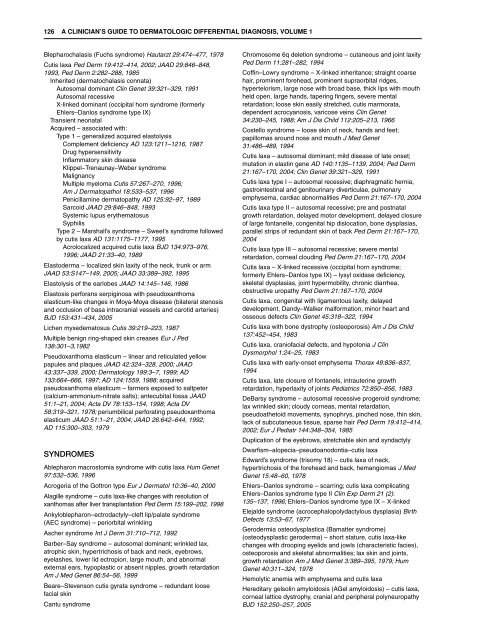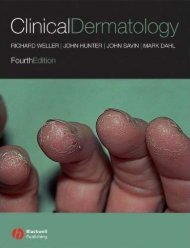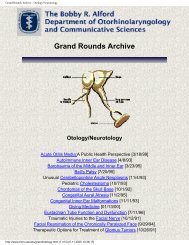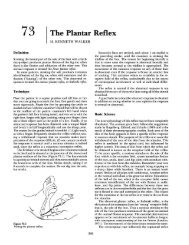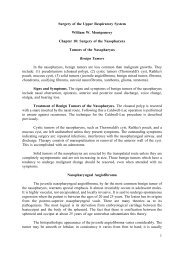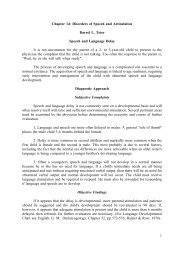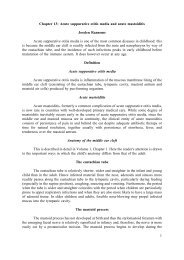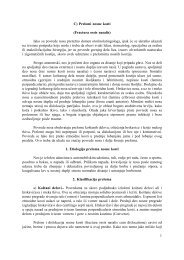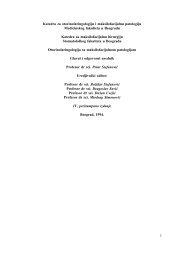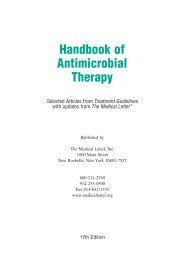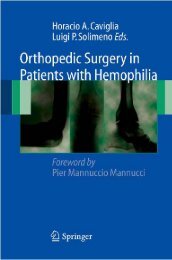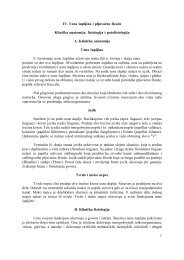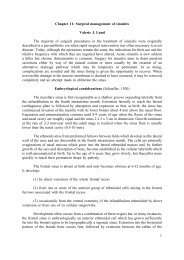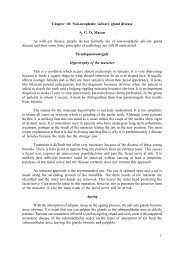- Page 2 and 3:
A Clinician’s Guide to Dermatolog
- Page 4 and 5:
A Clinician’s Guide to Dermatolog
- Page 6 and 7:
Contents Dedication ii Foreword vii
- Page 8 and 9:
Pore 524 Port wine stain 524 Preaur
- Page 10 and 11:
Introduction Dermatologic different
- Page 12 and 13:
ABSCESS AUTOIMMUNE DISEASES, AND DI
- Page 14 and 15:
Leishmaniasis (Leishmania major) -
- Page 16 and 17:
Kaposi’s sarcoma Lipoma - inflame
- Page 18 and 19:
philtrum, thin upper lip, broad mou
- Page 20 and 21:
Bacterial cellulitis Candida - Cand
- Page 22 and 23:
Comedo-like acantholytic dyskeratos
- Page 24 and 25:
Sepsis Streptococcus pneumoniae - w
- Page 26 and 27:
Subacute bacterial endocarditis Gha
- Page 28 and 29:
PRIMARY CUTANEOUS DISEASES Alopecia
- Page 30 and 31:
Necrolytic migratory erythema witho
- Page 32 and 33:
Self-healing juvenile cutaneous muc
- Page 34 and 35:
Perineurioma - soft tissue perineur
- Page 36 and 37:
Lipomatosis of the hands - Madelung
- Page 38 and 39:
Osteoarthritis Osteomalacia Polymyo
- Page 40 and 41:
DEGENERATIVE DISEASES Follicular de
- Page 42 and 43:
Multiple carboxylase deficiency - t
- Page 44 and 45:
Porokeratosis of Mibelli of the sca
- Page 46 and 47:
Dwarfism-alopecia-pseudoanodontia-c
- Page 48 and 49:
Multiple follicular hamartomas with
- Page 50 and 51:
XXYY syndrome - features of Klinefe
- Page 52 and 53:
Kabuki makeup syndrome - short stat
- Page 54 and 55:
ANGIOKERATOMA CORPORIS DIFFUSUM BJD
- Page 56 and 57:
Pinta Scabies Skin & Allergy News 2
- Page 58 and 59:
Terbinafine AD 131:960-961, 1995 Th
- Page 60 and 61:
somatostatin, sulfa, vigabatrin, pi
- Page 62 and 63:
Erythema gyratum perstans BJD 58:11
- Page 64 and 65:
Trisomy 13 (trisomy D (13-15) - mem
- Page 66 and 67:
Serum sickness NEJM 311:1407-1413,
- Page 68 and 69:
Rocky Mountain spotted fever Ghatan
- Page 70 and 71:
PRIMARY CUTANEOUS DISEASES Acne con
- Page 72 and 73:
Pachydermoperiostosis JAAD 38:359-3
- Page 74 and 75:
Familial dysautonomia (Riley-Day sy
- Page 76 and 77:
Onchocerciasis - atrophic changes e
- Page 78 and 79:
Immunocytoma, multiple cutaneous BJ
- Page 80 and 81:
type); hypertrophy of lower part of
- Page 82 and 83:
Follicular atrophoderma Bazex-Dupre
- Page 84 and 85:
Tricho-odonto-onycho-ectodermal dys
- Page 86 and 87: Onychomycosis - black nail Ghatan p
- Page 88 and 89: DRUG ERUPTIONS Linear fixed drug er
- Page 90 and 91: linear and whorled macular pigmenta
- Page 92 and 93: Carcinoid syndrome - flushing, patc
- Page 94 and 95: PHOTODERMATOSES Lichen planus actin
- Page 96 and 97: Pigmented purpuric eruption Purpura
- Page 98 and 99: PRIMARY CUTANEOUS DISEASES Atopic d
- Page 100 and 101: severe intrauterine growth retardat
- Page 102 and 103: Cinnarizine - lichen planus pemphig
- Page 104 and 105: Coxsackie A (5,9,10,16) - maculopap
- Page 106 and 107: INFILTRATIVE DISEASES Amyloidosis,
- Page 108 and 109: JEB cicatricial - autosomal recessi
- Page 110 and 111: Superficial mucocoele - oral bulla
- Page 112 and 113: INFLAMMATORY DISORDERS Erythema mul
- Page 114 and 115: BULLAE IN NEWBORN Textbook of Neona
- Page 116 and 117: with or without neuromuscular disea
- Page 118 and 119: Orf AD 126:356-358, 1990 Papular ur
- Page 120 and 121: INFECTIONS AND INFESTATIONS AIDS -
- Page 122 and 123: CALM and pulmonary stenosis Ann DV
- Page 124 and 125: Staphylococcus epidermidis AD 120:1
- Page 126 and 127: CHALKY MATERIAL EXTRUDED FROM LESIO
- Page 128 and 129: PHOTODERMATITIS Acute sunburn Rook
- Page 130 and 131: INFILTRATIVE DISEASES Amyloidosis I
- Page 132 and 133: Localized lichen myxedematosus (pap
- Page 134 and 135: Cowden’s syndrome (multiple hamar
- Page 138 and 139: Kabuki makeup syndrome - short stat
- Page 140 and 141: CTCL JAAD 29:331-334, 1993 Eruptive
- Page 142 and 143: IPEX syndrome - X-linked; immune dy
- Page 144 and 145: p.219, 2001; Rook p.636,1006 1998,
- Page 146 and 147: Ichthyosis Interstitial granulomato
- Page 148 and 149: Hypogammaglobulinemia Ghatan p.107,
- Page 150 and 151: Leprosy Lyme disease - including de
- Page 152 and 153: INFILTRATIVE DISEASES Langerhans ce
- Page 154 and 155: Famotidine (Pepcid) JAAD 31:671-678
- Page 156 and 157: and feet; atrophy with mottled hypo
- Page 158 and 159: EAR, HARD (PETRIFIED AURICLES) Cond
- Page 160 and 161: Protothecosis - verrucous plaque Sc
- Page 162 and 163: Granuloma faciale, extrafacial BJD
- Page 164 and 165: Greig cephalopolysyndactyly - malfo
- Page 166 and 167: Hemangiomas J Pediatr Surg 35:420-4
- Page 168 and 169: and face with perioral rugae; aged
- Page 170 and 171: Pyomyositis - with purpura JAAD 10:
- Page 172 and 173: Distichiasis-lymphedema syndrome -
- Page 174 and 175: Itraconazole AD 130:260-261, 1994 V
- Page 176 and 177: UNILATERAL FOOT EDEMA Freiberg’s
- Page 178 and 179: of the buttocks and thighs with ele
- Page 180 and 181: Lymphatic malformation Lymphedema -
- Page 182 and 183: Melanocytic nevi - erosions overlyi
- Page 184 and 185: Intravenous immunoglobulin (IVIG) B
- Page 186 and 187:
Keratosis-ichthyosis-deafness (KID)
- Page 188 and 189:
Psoriasis AD 136:875-880, 2000; Ped
- Page 190 and 191:
seborrheic dermatitis AD 138:117-12
- Page 192 and 193:
Psittacosis - morbilliform eruption
- Page 194 and 195:
urticarial, and rubella-like exanth
- Page 196 and 197:
CONGENITAL LESIONS Collodion baby R
- Page 198 and 199:
Dermatomyositis - eyelid edema JAAD
- Page 200 and 201:
METABOLIC DISEASES Acrodermatitis e
- Page 202 and 203:
vesiculopustules, red papules, crus
- Page 204 and 205:
dermatitis, cribriform scrotal atro
- Page 206 and 207:
urticaria, rhinoconjunctivitis Am J
- Page 208 and 209:
Parinaud’s oculoglandular fever -
- Page 210 and 211:
31:145-158, 1986; Am J Ophtalmol 88
- Page 212 and 213:
TOXINS Alkali burn Arsenic poisonin
- Page 214 and 215:
PSYCHOCUTANEOUS Anorexia nervosa -
- Page 216 and 217:
Ascher’s syndrome Carcinoid syndr
- Page 218 and 219:
Histoplasmosis in HIV disease Cutis
- Page 220 and 221:
Inverted follicular keratosis J Cli
- Page 222 and 223:
Cowden’s syndrome - trichilemmoma
- Page 224 and 225:
INFECTIONS AND INFESTATIONS Alterna
- Page 226 and 227:
Morphea, linear (en coup de sabre)
- Page 228 and 229:
PARANEOPLASTIC Bazex syndrome Necro
- Page 230 and 231:
Reactive perforating collagenosis U
- Page 232 and 233:
SELF-MUTILATION Hereditary sensory
- Page 234 and 235:
Calcium oxalate Am J Kid Dis 25:492
- Page 236 and 237:
Connective tissue disease - eosinop
- Page 238 and 239:
Herpes simplex infection, chronic i
- Page 240 and 241:
Thyroid releasing hormone Thyrotrop
- Page 242 and 243:
Diabetes mellitus Epidermolysis bul
- Page 244 and 245:
Dentist 24:65-69, 2004; Burkitt cel
- Page 246 and 247:
aldehyde Br Dent J 168:115-118, 199
- Page 248 and 249:
Job’s syndrome Kindler’s syndro
- Page 250 and 251:
Mukamel syndrome - autosomal recess
- Page 252 and 253:
Hypertension, post-traumatic Olfact
- Page 254 and 255:
Horner’s syndrome - medullary inf
- Page 256 and 257:
140:689-695, 1999; JID 103:277-281,
- Page 258 and 259:
Melanoma - verrucous and keratotic
- Page 260 and 261:
hyperkeratosis, sensorineural deafn
- Page 262 and 263:
Juvenile plantar dermatosis Acta DV
- Page 264 and 265:
PRIMARY CUTANEOUS DISEASE Acanthosi
- Page 266 and 267:
HYPERPIGMENTATION, DIFFUSE AUTOIMMU
- Page 268 and 269:
PHOTODERMATOSES Bronze baby syndrom
- Page 270 and 271:
Cyclophosphamide - black longitudin
- Page 272 and 273:
Liver disease, chronic - diffuse mu
- Page 274 and 275:
Pigmentary mosaicism - phylloid hyp
- Page 276 and 277:
Pigmented purpuric eruptions includ
- Page 278 and 279:
Kaposi’s sarcoma in AIDS JAAD 22:
- Page 280 and 281:
Penicillamine Rook p.3395, 1998, Si
- Page 282 and 283:
Schinzel-Giedion syndrome - autosom
- Page 284 and 285:
Hairy cutaneous malformation of the
- Page 286 and 287:
METABOLIC Acromegaly - hirsutism in
- Page 288 and 289:
Cornelia de Lange syndrome - specif
- Page 290 and 291:
plugged pit; may be verrucous; fili
- Page 292 and 293:
Corticosteroids - injected; topical
- Page 294 and 295:
Progressive macular hypomelanosis A
- Page 296 and 297:
Laser Traumatic scars Clin Inf Dis
- Page 298 and 299:
NEOPLASTIC Kaposi’s sarcoma JAAD
- Page 300 and 301:
mutation in gene encoding 3β-hydro
- Page 302 and 303:
Bruton’s hypogammaglobulinemia -
- Page 304 and 305:
Epidermolysis bullosa acquisita IgA
- Page 306 and 307:
Atopic dermatitis Confluent and ret
- Page 308 and 309:
Romberg’s syndrome - heterochromi
- Page 310 and 311:
PSYCHOCUTANEOUS DISEASES Bulimia ne
- Page 312 and 313:
spot lentigo (reticulated black sol
- Page 314 and 315:
BJD 144:594-596, 2001; JAAD 44:273-
- Page 316 and 317:
TRAUMA Minor trauma Dermatol Clin 6
- Page 318 and 319:
Trichothiodystrophy syndromes - BID
- Page 320 and 321:
Leeches Leishmaniasis - post-kala-a
- Page 322 and 323:
AD 109:526-528, 1974; unilateral pu
- Page 324 and 325:
SYNDROMES Aarskog syndrome - single
- Page 326 and 327:
TOXINS Arsenical keratoses Eosinoph
- Page 328 and 329:
Ehlers-Danlos syndrome, type IV - p
- Page 330 and 331:
METABOLIC DISEASES Milia-like calci
- Page 332 and 333:
Pemphigus vulgaris Scleroderma Sjö
- Page 334 and 335:
Down’s syndrome Familial cold urt
- Page 336 and 337:
enal failure; associated with hepat
- Page 338 and 339:
2003; JAAD 31:561-566, 1994; Ann Rh
- Page 340 and 341:
Lipomas BJD 146:125-128, 2002; J Fo
- Page 342 and 343:
Familial mitral valve prolapse synd
- Page 344 and 345:
Ganglioneuroma of cervical sympathe
- Page 346 and 347:
Nailbed or nailplate hemorrhage Rup
- Page 348 and 349:
METABOLIC DISEASES Homocystinuria -
- Page 350 and 351:
Epstein’s pearls (milia) in oral
- Page 352 and 353:
Reticular erythematous mucinosis Se
- Page 354 and 355:
Darier’s disease Granuloma facial
- Page 356 and 357:
PSYCHOCUTANEOUS DISEASES Factitial
- Page 358 and 359:
Phaeoacremonium inflatipes - fungem
- Page 360 and 361:
Lichen spinulosus JAAD 22:261-264,
- Page 362 and 363:
facial asymmetry, macrostomia, epib
- Page 364 and 365:
Juvenile hyaline fibromatosis (syst
- Page 366 and 367:
INFECTIONS AND INFESTATIONS Acantha
- Page 368 and 369:
Phaeohyphomycosis, subcutaneous Ped
- Page 370 and 371:
PHOTODERMATITIS Hydroa vacciniforme
- Page 372 and 373:
Congestive heart failure Overwhelmi
- Page 374 and 375:
CONGENITAL AND/OR ACQUIRED NEVI Bar
- Page 376 and 377:
lipoatrophic streaks extend down le
- Page 378 and 379:
Congenital self-healing Langerhans
- Page 380 and 381:
Epidermoid cysts, plantar - HPV-60-
- Page 382 and 383:
INFLAMMATORY DISEASES Bunion Extrav
- Page 384 and 385:
IgM storage papule - pink or skin-c
- Page 386 and 387:
Nevus lipomatosis superficialis - m
- Page 388 and 389:
1990; Nephron 53:73-75, 1989; dialy
- Page 390 and 391:
JAAD 47:251-257, 2002; JAAD 45:596-
- Page 392 and 393:
Syphilis Sex Transm Dis 14:52-53, 1
- Page 394 and 395:
Vascular calcification - cutaneous
- Page 396 and 397:
Arteriovenous fistulae - congenital
- Page 398 and 399:
papules JAAD 44:324-329, 2001; prim
- Page 400 and 401:
Squamous cell carcinoma Sweat gland
- Page 402 and 403:
Leprosy - lepromatous leprosy Rook
- Page 404 and 405:
Desmoid tumor - subcutaneous mass i
- Page 406 and 407:
PRIMARY CUTANEOUS DISEASES Axillary
- Page 408 and 409:
Hemangiopericytoma JAAD 37:887-920,
- Page 410 and 411:
Langerhans cell histiocytosis - ulc
- Page 412 and 413:
Noonan’s syndrome - keloids Regre
- Page 414 and 415:
Malignant fibrous histiocytoma Mela
- Page 416 and 417:
JAAD 12:207-212, 1985 Phialophora r
- Page 418 and 419:
Merkel cell tumor AD 140:609-614, 2
- Page 420 and 421:
esponse element binding protein Ped
- Page 422 and 423:
Basan’s syndrome Dermatopathia pi
- Page 424 and 425:
PRIMARY CUTANEOUS DISEASES Alopecia
- Page 426 and 427:
INFECTIONS Abscess of buccal mucosa
- Page 428 and 429:
PRIMARY CUTANEOUS DISEASES Acanthos
- Page 430 and 431:
Calcium channel blockers J Am Dent
- Page 432 and 433:
Desquamative gingivitis Eosinophili
- Page 434 and 435:
Muckle-Wells syndrome Am J Med Gene
- Page 436 and 437:
Plaquenil Quinacrine Quinidine - bl
- Page 438 and 439:
Malignant schwannoma (neurofibrosar
- Page 440 and 441:
METABOLIC DISEASES Acrodermatitis e
- Page 442 and 443:
heel Ped Derm 21:655-656, 2004; Med
- Page 444 and 445:
AD 124:1678-1682, 1988; JAAD 13:908
- Page 446 and 447:
Porokeratosis of Mantoux - craterif
- Page 448 and 449:
Epidermolytic hyperkeratosis (bullo
- Page 450 and 451:
Sclerodactyly, non-epidermolytic pa
- Page 452 and 453:
Incontinentia pigmenti - plantar hy
- Page 454 and 455:
Type IX - PPK with sclerodactyly, H
- Page 456 and 457:
Eccrine nevus - brown papule JAAD 5
- Page 458 and 459:
J Trop Med Hyg 89:43-45, 1986; Bol
- Page 460 and 461:
Relapsing linear acantholytic derma
- Page 462 and 463:
Keratoacanthoma - digital papule AD
- Page 464 and 465:
PHOTODERMATOSES Disseminated superf
- Page 466 and 467:
Mixed tumor of the face J Dermatol
- Page 468 and 469:
Fibroepithelioma of Pinkus - flat-t
- Page 470 and 471:
Bacterial folliculitis, usually sta
- Page 472 and 473:
Atrophoderma vermiculatum Ped Derm
- Page 474 and 475:
widespread dermatitis, palmoplantar
- Page 476 and 477:
Juvenile xanthogranuloma Dis Chest
- Page 478 and 479:
SYNDROMES Alagille syndrome (arteri
- Page 480 and 481:
Papular urticaria Roseola infantum
- Page 482 and 483:
Irritant contact dermatitis Sea urc
- Page 484 and 485:
Tanapox - pruritic papule, initiall
- Page 486 and 487:
Neurofibroma Neuroma, including sol
- Page 488 and 489:
Angiomas, eruptive - treatment with
- Page 490 and 491:
Poroma - papilloma, especially of s
- Page 492 and 493:
Toxoplasmosis - pityriasis lichenoi
- Page 494 and 495:
Keratoacanthoma visceral carcinoma
- Page 496 and 497:
Bowen’s disease AD 130:204-209, 1
- Page 498 and 499:
Primary lymphoma Leuk Lymphoma 26:4
- Page 500 and 501:
Granular cell tumor (granular cell
- Page 502 and 503:
paraffinoma resulting in penile enl
- Page 504 and 505:
Basal cell carcinoma Genital Skin D
- Page 506 and 507:
myopathy JAAD 53:639-643, 2005; AD
- Page 508 and 509:
Amebiasis - Entameba histolytica De
- Page 510 and 511:
Candidiasis Int J Derm 38:618-622,
- Page 512 and 513:
PERIANAL ULCERS, SINGLE OR MULTIPLE
- Page 514 and 515:
testis, nasopharyngeal carcinoma; l
- Page 516 and 517:
Syphilis - primary (chancre), secon
- Page 518 and 519:
Psoriasis Seborrheic dermatitis Vit
- Page 520 and 521:
Alprazolam (Xanax) - phototoxic JAA
- Page 522 and 523:
Oxyphenbutazone - UVA Paraquat - du
- Page 524 and 525:
Occlusive dressings - photosensitiv
- Page 526 and 527:
Variegate porphyria - weatherbeaten
- Page 528 and 529:
Pityriasis rubra pilaris - seborrhe
- Page 530 and 531:
Salvarson Thiazides Tripelennamine
- Page 532 and 533:
Juvenile plantar dermatosis Lamella
- Page 534 and 535:
Poikiloderma vasculare atrophicans
- Page 536 and 537:
Parkes-Weber syndrome - port wine s
- Page 538 and 539:
contractures; taut shiny skin; feta
- Page 540 and 541:
Red sea coral contact dermatitis In
- Page 542 and 543:
BJD 152:1085-1086, 2005; BJD 152:3-
- Page 544 and 545:
PSYCHOCUTANEOUS DISEASES Anorexia n
- Page 546 and 547:
Terbinifine JAAD 36:858-862, 1997 T
- Page 548 and 549:
SYNDROMES Arthropathy, rash, chroni
- Page 550 and 551:
Lipoid proteinosis BJD 151:413-423,
- Page 552 and 553:
Myotonic dystrophy Syndromes of the
- Page 554 and 555:
Mutation in 3β-hydroxysteroid dehy
- Page 556 and 557:
virus (Southeast Brazil), Whitewate
- Page 558 and 559:
Leptospirosis Meningococcemia Pneum
- Page 560 and 561:
Calciphylaxis Chronic renal failure
- Page 562 and 563:
Dermatosparaxis - easy bruisability
- Page 564 and 565:
Acroangiodermatitis (gravitational
- Page 566 and 567:
DRUG-INDUCED Dilantin hypersensitiv
- Page 568 and 569:
Streptococcus viridans Strongyloide
- Page 570 and 571:
Fogo selvagem JAAD 20:657, 1989 Her
- Page 572 and 573:
Coccidioidomycosis - papulopustules
- Page 574 and 575:
Tularemia - Franciscella tularensis
- Page 576 and 577:
SYNDROMES Behçet’s disease - pap
- Page 578 and 579:
Corticosteroid (topical) atrophy; s
- Page 580 and 581:
Robert’s syndrome (hypomelia-hypo
- Page 582 and 583:
hyperkeratoses extending over Achil
- Page 584 and 585:
PRIMARY CUTANEOUS DISEASES Acne vul
- Page 586 and 587:
Helicobacter cinaedi - cellulitis A
- Page 588 and 589:
Squamous cell carcinoma - intraoral
- Page 590 and 591:
Radiation mucositis - intraoral red
- Page 592 and 593:
Post-vaccination Semin Pediatr Infe
- Page 594 and 595:
Parvovirus B19 infection - red/viol
- Page 596 and 597:
Eccrine angiomatous hamartoma Eccri
- Page 598 and 599:
Muckle-Wells syndrome Multicentric
- Page 600 and 601:
PARANEOPLASTIC DISEASES Cutis verti
- Page 602 and 603:
INFECTIONS Coxsackie B4 hemorrhagic
- Page 604 and 605:
Hunter’s syndrome - decreased sul
- Page 606 and 607:
Progressive cribriform and zosterif
- Page 608 and 609:
Pilar cyst (trichilemmal cyst) JAAD
- Page 610 and 611:
Ectodermal dysplasias with clefting
- Page 612 and 613:
Melanocytic nevus Rook p.1722-1723,
- Page 614 and 615:
Microcystic adnexal carcinoma - ski
- Page 616 and 617:
Burns Carcinoma Dental sinus Eczema
- Page 618 and 619:
INFECTIONS OR INFESTATIONS Brucello
- Page 620 and 621:
GEMSS syndrome - autosomal dominant
- Page 622 and 623:
Verruciform xanthoma BJD 150:161-16
- Page 624 and 625:
EXOGENOUS AGENTS Mustard gas exposu
- Page 626 and 627:
INFLAMMATORY DISORDERS Erythema mul
- Page 628 and 629:
Abruzzo-Erickson syndrome (cleft pa
- Page 630 and 631:
Kenny syndrome (tubular stenosis) C
- Page 632 and 633:
Tay syndrome - autosomal recessive,
- Page 634 and 635:
Russell-Silver syndrome - large hea
- Page 636 and 637:
Dissecting cellulitis of the scalp
- Page 638 and 639:
Squamous cell carcinoma Staphylococ
- Page 640 and 641:
Nasal alar colobomas, mirror hands
- Page 642 and 643:
Mycobacterium avium-intracellulare
- Page 644 and 645:
TATTOO, PALPABLE: LESIONS IN A TATT
- Page 646 and 647:
hypodontia, short upper lip bound d
- Page 648 and 649:
Coats’ disease - cutaneous telang
- Page 650 and 651:
NEOPLASTIC DISEASES Actinic keratos
- Page 652 and 653:
Neurofibromatosis - usually unilate
- Page 654 and 655:
Candidiasis Ghatan p.93, 2002, Seco
- Page 656 and 657:
Plummer-Vinson syndrome AD 105:720,
- Page 658 and 659:
INFLAMMATORY DISORDERS Crohn’s di
- Page 660 and 661:
exanthem with islands of sparing (
- Page 662 and 663:
74:278-281, 2000; Br J Plast Surg 5
- Page 664 and 665:
central scaling, scarring, atrophy,
- Page 666 and 667:
Cryptococcosis - punched out ulcers
- Page 668 and 669:
Ulcers with regional adenopathy - a
- Page 670 and 671:
Type 9 - ACC as feature of malforma
- Page 672 and 673:
Sclerosing lymphangitis of the peni
- Page 674 and 675:
Rat bite fever Rhizopus azygosporus
- Page 676 and 677:
Felty’s syndrome - arthritis, leu
- Page 678 and 679:
Sixth Edition; Int J Dermatol 27:49
- Page 680 and 681:
Omphalitis - periumbilical erythema
- Page 682 and 683:
DeBarsey syndrome - umbilical herni
- Page 684 and 685:
Pyoderma gangrenosum-like lesions,
- Page 686 and 687:
DRUG-INDUCED ACE inhibitors - lisin
- Page 688 and 689:
Eosinophilic pustular folliculitis
- Page 690 and 691:
cold-induced cholinergic urticaria
- Page 692 and 693:
Phenylbutazone Phenytoin Piperazine
- Page 694 and 695:
LYMPHOCYTIC Peripheral vascular dis
- Page 696 and 697:
Cryptococcosis Leishmaniasis - leis
- Page 698 and 699:
Leishmaniasis - verrucous form of l
- Page 700 and 701:
Pagetoid reticulosis AD 125:402-406
- Page 702 and 703:
VASCULAR Angiokeratomas Angiokerato
- Page 704 and 705:
Thermal burn - child abuse; vulvar
- Page 706 and 707:
DRUGS Corticosteroid-induced fat ne
- Page 708 and 709:
PSYCHOCUTANEOUS DISEASES Factitial
- Page 710 and 711:
Kaposi’s sarcoma Tyring p.224, 20
- Page 712 and 713:
Phenylthiourea - hypopigmentation o
- Page 714 and 715:
Griscelli’s syndrome Hallerman-St
- Page 716 and 717:
Vogt-Koyanagi-Harada syndrome - occ
- Page 718 and 719:
Connective tissue nevus Ped Derm 22
- Page 720 and 721:
Retinoid dermatitis - isotretinoin,
- Page 722 and 723:
YELLOW NAIL SYNDROME JAAD 28:792-79
- Page 724 and 725:
lesions BJ Clin Pract 27:271-273, 1
- Page 726 and 727:
PRIMARY CUTANEOUS DISEASE Atopic de
- Page 728 and 729:
Plane xanthomas - normolipemic plan
- Page 730 and 731:
Dermatomyositis - centripetal flage
- Page 732 and 733:
ZOSTERIFORM LESIONS/SEGMENTAL DISOR
- Page 734 and 735:
PHOTODERMATOSES Favre-Racouchot syn


